Application and Development of UV-Curable Adhesives in Lithium-Ion Batteries(Part 1:Performance Evaluation and Key Challenges)
Release time:
2025-07-12
Introduction: Why Do Lithium Batteries Need UV-Curable Adhesives?
With the global energy transition and the rapid growth of the electric vehicle market, the lithium-ion battery industry is facing triple urgent demands: higher production efficiency, cost control, and environmental sustainability. For years, the traditional system of polyvinylidene fluoride (PVDF) adhesives with N-methyl-2-pyrrolidone (NMP) solvent has dominated electrode manufacturing. However, the shortcomings of this system are becoming increasingly apparent:
The NMP solvent recovery process is highly energy-intensive.
The potential biotoxicity of NMP poses environmental and health risks.
The lengthy drying process severely limits production speed and requires significant factory floor space.
Against this backdrop, ultraviolet (UV) curing technology has emerged as an efficient, energy-saving, “green technology.” UV-curable adhesive systems use 100% solid content or low-VOC formulations and cure within seconds through photoinitiated polymerization, eliminating the need for high-temperature baking. This characteristic not only revolutionizes production efficiency and significantly reduces equipment footprint but also eliminates harmful solvents like NMP from the source, greatly reducing manufacturing costs and environmental impact.
Therefore, introducing UV-curable adhesives is not merely a simple technological upgrade—it is a strategic choice to address industry bottlenecks and increasingly stringent environmental regulations. UV curing is viewed as a disruptive solution that reduces environmental impact, speeds up manufacturing, cuts battery costs, and even offers potential improvements in battery performance, cycle life, and safety.
However, despite these clear advantages, how do these new adhesives actually perform in the harsh electrochemical environment inside batteries? What unique performance challenges do they face that traditional materials do not? This article delves into the fundamental performance evaluation system of UV-curable adhesives, revealing both the opportunities and challenges in their practical application.
The Core Role and Evaluation System of Lithium-Ion Battery Adhesives
Before diving deeper, it is essential to understand the critical role adhesives play in lithium-ion battery electrodes. Adhesives are polymer materials whose primary function is to firmly bond the active material particles (CAM), conductive agents (such as carbon black), and metal current collectors (such as aluminum foil) together, forming a mechanically stable structure with a good conductive network. This structural integrity is vital for maintaining long-term stability during the repeated charge and discharge cycles of the battery.
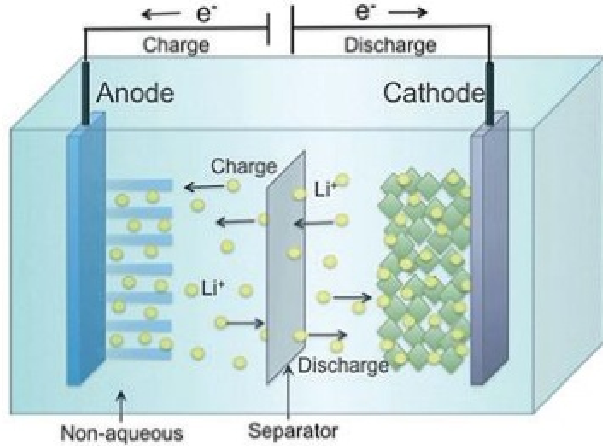
[Diagram: Basic Structure of a Lithium-Ion Battery, showing cathode, anode, separator, and electrolyte. (Source: UV+EB Technology, 2023 Q2)](Image reference)
To systematically evaluate the performance of UV-curable adhesives, we have established a multi-dimensional evaluation framework, mainly covering the following three aspects:
Electrochemical Performance: The most intuitive indicator of whether the battery “works well,” including how much energy the battery can store (charge/discharge specific capacity), how long the energy can be retained (capacity retention rate), and how fast charging/discharging can be (rate capability).
Electrochemical Impedance (EIS): A deeper diagnostic tool that reflects the efficiency of internal ion and electron transport by measuring the cell’s internal resistance. It reveals intrinsic dynamic characteristics of the materials and is key to understanding performance differences.
Physical Stability: Concerns the battery’s durability and safety, focusing on the adhesion strength between the adhesive and other components and whether excessive swelling in the electrolyte could damage the electrode structure.
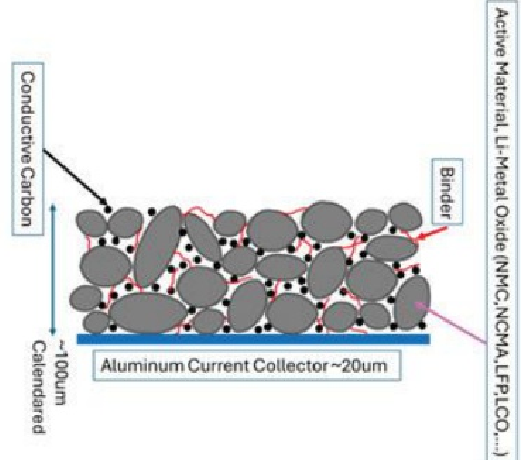
[Diagram: Cathode Structure—active material particles (gray), conductive carbon (black), and adhesive (red) attached to aluminum current collector. (Source: UV+EB Technology, 2023 Q2)](Image reference)
Key Performance Indicator I: In-Depth Analysis of Electrochemical Performance
Macroscopic electrochemical performance is the first critical benchmark for assessing the feasibility of UV-curable adhesives. Research data shows that well-designed UV-curable adhesive systems perform excellently in this area, fully matching or even surpassing the performance of traditional PVDF systems in some respects.
Charge-Discharge Curve Analysis
The voltage-specific capacity curve is often referred to as the battery’s “fingerprint.” The figure below shows the typical charge-discharge curves of an NMC811 cathode using UV-curable adhesive at a C/10 rate. It is clear that the charge and discharge plateaus are distinct, and the initial discharge specific capacity approaches 200 mAh/g—comparable to electrodes using traditional PVDF adhesives. This demonstrates that UV-curable adhesive systems can effectively enable the active material to deliver its lithium storage capacity.
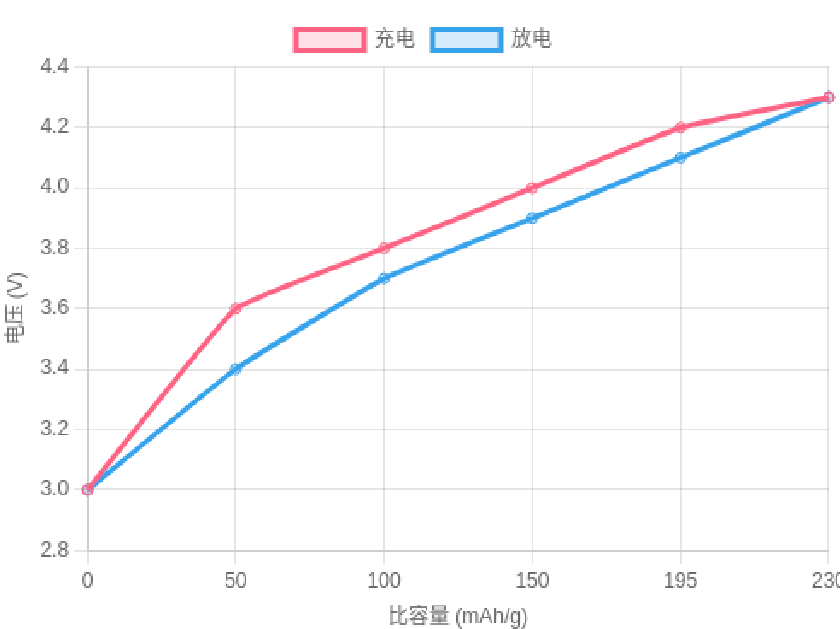
Diagram: Typical Charge-Discharge Curves of UV-Cured Adhesive Electrodes (Data source: UV+EB Technology, 2023 Q2, Figure 5)
Capacity Retention Analysis
Long-term cycling stability is crucial for determining battery life. The figure below compares the capacity retention rates of UV-curable adhesives and traditional PVDF adhesives after multiple cycles. The data shows that two different UV adhesive formulations maintained capacity retention rates above 88% even after 300 cycles, while the traditional PVDF system dropped to around 80% after approximately 200 cycles. This suggests that the stable network structure formed by UV-curable adhesives may be more conducive to maintaining electrode integrity during long-term cycling, thus demonstrating superior cycle life potential.
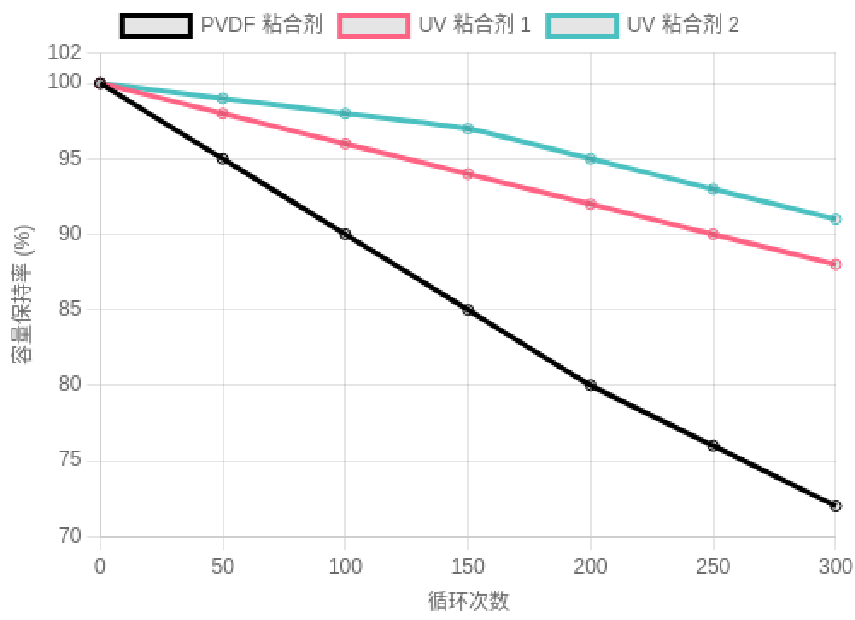
Diagram: Capacity Retention Comparison Between UV-Curable Adhesive and PVDF Adhesive (Data source: UV+EB Technology, 2023 Q2, Figure 6)
Rate Performance Analysis
Rate performance reflects a battery’s ability to charge and discharge rapidly. The figure below presents the specific capacity performance of UV-curable adhesive systems compared to PVDF systems at different charge-discharge rates (C-rates). The results show that the rate performance curves of the two systems almost completely overlap, indicating that UV-curable adhesives can also provide effective ion and electron transport channels during rapid lithium-ion insertion/extraction, meeting the demands of fast-charging and other high-performance applications.
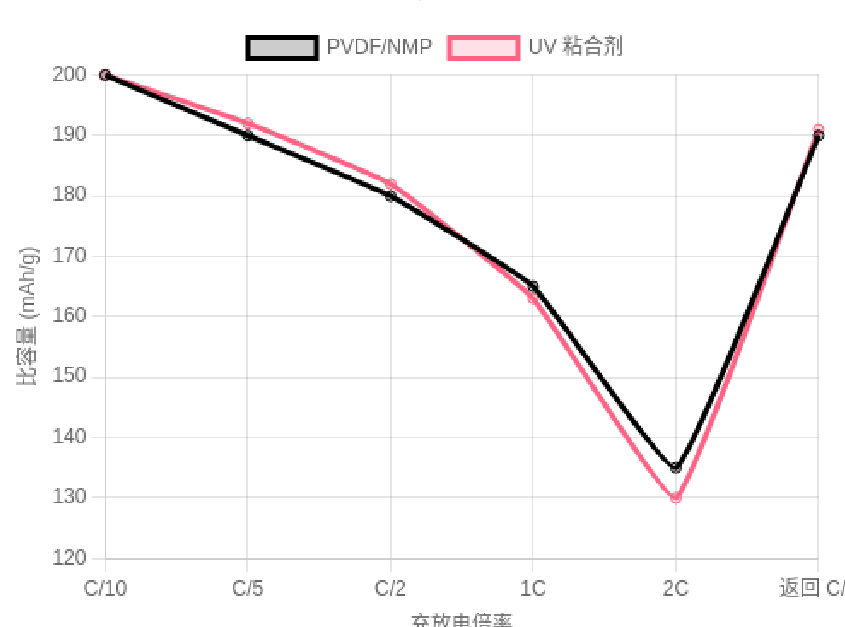
Diagram: Rate Performance Comparison Between UV-Curable Adhesive and PVDF Adhesive (Data source: UV+EB Technology, 2023 Q2, Figure 7)
Key Performance Indicator II: Preliminary Exploration of Electrochemical Impedance Spectroscopy (EIS)
Electrochemical Impedance Spectroscopy (EIS) is a powerful non-destructive diagnostic technique that applies a small AC signal to probe the various resistance components inside a battery. The results are typically presented as Nyquist plots, where different regions correspond to different physicochemical processes.
The high-frequency region’s intercept with the X-axis represents the battery’s ohmic resistance (RΩ), which mainly comes from the electrolyte and electrode materials themselves.
The semicircle in the mid-to-high frequency region corresponds to the charge transfer resistance (Rct) at the electrode/electrolyte interface, reflecting how easily lithium ions participate in electrochemical reactions at this boundary.
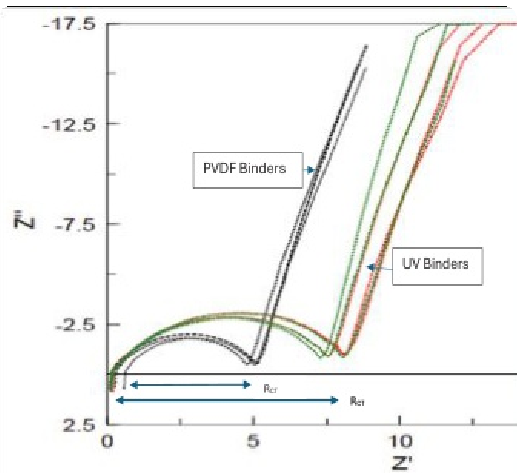
Diagram: Nyquist Plot Comparing UV-Curable Adhesive (red and green) vs. PVDF (black); UV systems show significantly larger semicircle diameters. (Source: UV+EB Technology, 2023 Q2, Figure 9)
The comparative test results above reveal an intriguing and crucial phenomenon: although UV-curable adhesives exhibit excellent macroscopic electrochemical performance, their charge transfer resistance (Rct)—reflected in the larger semicircle diameter—is significantly higher than that of traditional PVDF systems (approximately 7.5 ohms vs. 5 ohms).
At first glance, this seems contradictory: how can a system with higher internal resistance still deliver comparable or even superior performance?
This phenomenon suggests that the unique crosslinked network structure of UV-curable adhesives may be influencing ion transport pathways at the microscopic level. What lies behind this seemingly paradoxical behavior? The material science mechanisms underlying this will be explored in depth in the next part.
Key Performance Indicator III: Challenges and Verification of Physical Stability
In addition to electrochemical performance, the physical stability of adhesives—being structural materials—directly affects the long-term reliability and safety of lithium-ion batteries. This stability is primarily reflected in two aspects: adhesion strength and electrolyte uptake/swelling behavior.
Adhesion Strength
To simulate the harsh internal environment of batteries, researchers conducted 90-degree peel tests on UV-cured electrodes after immersion in electrolyte. The results showed that UV-curable adhesives exhibited excellent adhesion retention. As the figure below illustrates, even after soaking in electrolyte for up to two weeks, the peel strength fluctuated only slightly and consistently remained at a high level. This demonstrates that the chemically crosslinked network formed by UV curing provides outstanding resistance to electrolyte corrosion, effectively preventing issues such as active material pulverization and detachment from the current collector during long-term use.
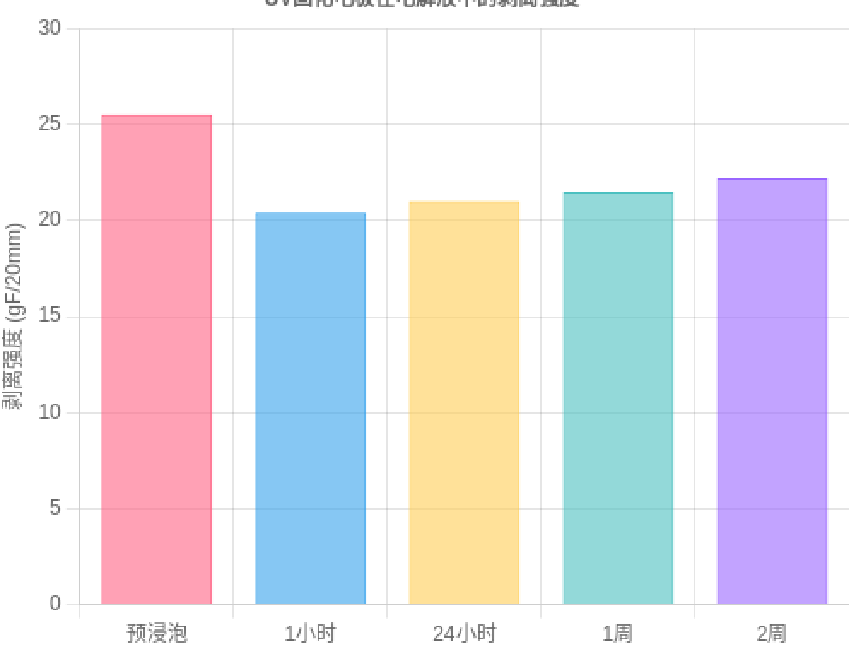
Diagram: Peel Strength of UV-Cured Electrodes After Immersion in Electrolyte for Different Durations (Data source: UV+EB Technology, 2023 Q2, Figure 11)
Electrolyte Uptake and Swelling
The adhesive’s absorption of electrolyte is a double-edged sword. Moderate absorption (wetting) can facilitate lithium-ion transport within the electrode, but excessive absorption leads to swelling, which disrupts the dense electrode structure, increases interfacial resistance, and may even cause electrode delamination.
Studies show that traditional PVDF adhesives can reach electrolyte absorption rates of 11%–19% after 48 hours of immersion. In contrast, UV-curable adhesive systems demonstrate significantly lower electrolyte uptake: after immersion at 60°C for two weeks, the absorption rate only increased slightly from 3.8% to 4.3%. This low-swelling characteristic is highly beneficial for maintaining dimensional stability and structural integrity of the electrode, which is one of the key reasons behind the superior long-term cycling performance of UV-cured adhesives.
Key Takeaways from Part I
UV-curable adhesives, as a green and efficient technology, offer substantial potential for cost reduction and efficiency improvement in lithium battery manufacturing.
In macroscopic electrochemical performance, UV adhesive systems can match or even exceed traditional PVDF systems in terms of specific capacity, cycle life, and rate performance.
In physical stability, UV-curable adhesives demonstrate outstanding adhesion strength and ultra-low electrolyte swelling, which are crucial for long-term battery reliability.
A key scientific question arises: EIS tests reveal that UV-curable adhesives have higher charge transfer resistance—seemingly at odds with their superior macroscopic performance.
Summary and Outlook
Through systematic evaluation of fundamental properties, we can conclude that UV-curable adhesives—as next-generation lithium-ion battery adhesive technology—have enormous potential and their feasibility has been initially validated. They not only address environmental and efficiency bottlenecks of traditional processes but also exhibit strong competitiveness in key electrochemical and physical properties.
However, the “high impedance” phenomenon discovered in EIS testing emerges as a crucial clue, unlocking a gateway to deeper material science mechanisms. To truly harness and optimize this technology, we must understand how its unique chemical crosslinking process shapes the polymer’s microscopic world, ultimately determining its performance.
The answer to this question will be revealed in Part II.
*Data source: UV+EB Technology, 2025 Q1/Q2
Latest News
Get a Free Consultancy
NANTONG EASTO MATERIALS TECHNOLOGY CO.,LTD.

No.118,Zhujiang Rd.,Juegang St.,Rudong County,
Nantong City,Jiangsu Province,226400,China



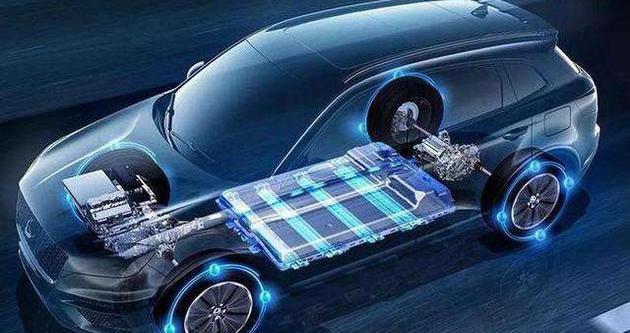
 2025-07-12
2025-07-12






